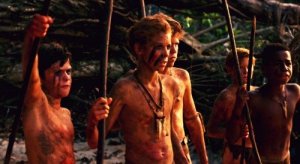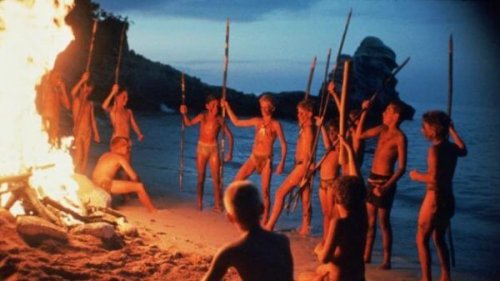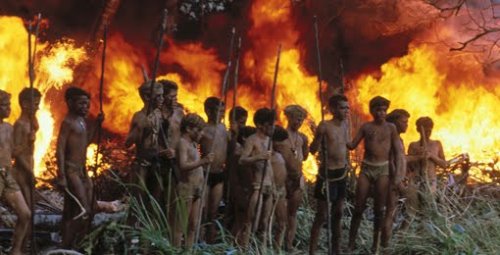Lord of the Flies: Creating a Society

Lord of the Flies (1954) is William Golding’s most recognized work. It didn’t have a great impact during his time. However, it experienced a revival years later, becoming a classic in post-war English literature. It was brought to the big screen twice, first in 1963 and then in 1990.
Lord of the Flies is an allegory of human nature, where each character represents an important aspect of humanity. It explores children creating a society from scratch. How are the roles assigned? How is a leader chosen?
The plot begins when an airplane with young passengers crashes near a desert island. The survivors must organize themselves in order to survive and be rescued. A new society emerges on an island in the middle of nowhere, with no existing standards. Throughout the novel, we discover how any person can become evil, regardless of their age. Lord of the Flies is all about evil and human nature’s different facets.
“The greatest ideas are the simplest.”
–Lord of the Flies–
Children, leaders, and allegory
The title of the book is allegorical. It alludes to Beelzebub, to evil. In the novel, this evil is the boar’s head, which the children place on a spear. Flies surround the decomposing head.
When the children reach the island, they come together with the hope of surviving and being found as soon as possible, demonstrating that humans are social by nature. Perhaps conditioned by the society where they’ve grown up or perhaps due to their fear and instinct for survival, the children decide to choose a leader democratically. Their leader is Ralph, who isn’t the smartest child but is agile, strong, and inspires trust in the others.

What could have been their opportunity to challenge the adults and show that children can be fairer and more rational ends up being a real catastrophe. Rivalry arises as soon as a leader is elected. This rivalry leads to hatred and finally to a tragic and out of control situation.
Main characters and their traits
- Ralph is the leader chosen by the rest of the children. He represents democracy, has good intentions, and wants the children to remain united. He’s the one who decides to keep a fire lit in hopes of being seen and rescued. Despite his good intentions, he always consults Piggy and ends up losing control and leadership.
- Jack, Ralph’s counterpart, is another born leader. However, he’s authoritarian. He’s the oldest of the group but isn’t elected leader, which bothers him. He has an arrogant and pessimistic attitude and has lost hope of being rescued. Little by little, he becomes more and more irrational and increasingly violent. The other children become fearful of him and thus join him.
- Piggy is mocked due to his appearance and asthma. However, he’s one of the most intelligent characters and represents rationality. Due to his appearance and poor physical condition, no one considers choosing him as a leader. Despite this, Ralph trusts him and always asks for his help.
- Simon, like Piggy, isn’t in good health. He’s reserved and shy, but shows great sensitivity, especially toward animals. This truly revealing character discovers the “Lord of the Flies” and acts as the bearer of truth.
- Roger is on Ralph’s side in the beginning but ends up as Jack’s right-hand man. Roger seems like a quiet and shy boy, but he soon discovers another side of himself. Seeing that no laws exist and that there won’t be any consequences to his actions, he starts being violent.
These children establish a hierarchy, an order inspired by the world they know. But this hierarchy is ultimately broken and radicalized. Faced with fear, they decide they don’t need a rational leader, but a strong one who guarantees them peace and food.
“What are we? Humans? Or animals? Or savages?”
–Lord of the Flies–

The nature of evil in Lord of the Flies
Lord of the Flies intends to “destroy” Rousseau, who said that human beings are naturally kind and not evil. According to Rousseau, society corrupts human beings. In the novel, the opposite happens. The children are free and in a totally natural state. But in the absence of society and its rules, they get carried away by their evil nature, acting in a totally irrational way.
On the other side of the coin is Hobbes, who says society regulates evil and makes us behave as rational beings. But in Golding’s work, the children can’t help but feel that they don’t have to obey anyone on the island, despite trying to choose a leader and establish a society.
We see that, at first, they try to imitate the world and the adults they know. They find a conch shell they consider a democratic symbol, which they use to give others turns to speak. They organize themselves in order to keep the fire burning and to get food. But this democratic utopia ends up failing.
Some children see the island as a dream place since there are no parents or teachers. Why would they obey? Why behave according to the rules? Leaders play a crucial role, and the children choose which side they want to be on until a war breaks out.
The rumor that a beast inhabits the island makes the children fearful, thus supporting the stronger leader. Others feel the freedom to unleash their wildest instincts. Thus, the island, which was initially a paradise, ends up becoming the center of terrible destruction.
“This is our Island, it’s a good Island. Until the grown-ups come to fetch us we’ll have fun.”
–Lord of the Flies-

Reflections
Lord of the Flies not only speaks of human nature and the loss of innocence. In their own way, these children create a new hierarchy from scratch in which we see different roles that remind us of the real world.
The children become divided, as we do with political ideas. They face each other as people do in wars. They don’t reward intelligence nor look for a reasonable leader. Instead, they want a strong leader who can protect them from what they fear.
All of this reminds us of the world we live in and how we choose our leaders. It makes us ask ourselves if democracy really exists or is even possible.
“…fear can’t hurt you any more than a dream.”
–Lord of the Flies-
Lord of the Flies (1954) is William Golding’s most recognized work. It didn’t have a great impact during his time. However, it experienced a revival years later, becoming a classic in post-war English literature. It was brought to the big screen twice, first in 1963 and then in 1990.
Lord of the Flies is an allegory of human nature, where each character represents an important aspect of humanity. It explores children creating a society from scratch. How are the roles assigned? How is a leader chosen?
The plot begins when an airplane with young passengers crashes near a desert island. The survivors must organize themselves in order to survive and be rescued. A new society emerges on an island in the middle of nowhere, with no existing standards. Throughout the novel, we discover how any person can become evil, regardless of their age. Lord of the Flies is all about evil and human nature’s different facets.
“The greatest ideas are the simplest.”
–Lord of the Flies–
Children, leaders, and allegory
The title of the book is allegorical. It alludes to Beelzebub, to evil. In the novel, this evil is the boar’s head, which the children place on a spear. Flies surround the decomposing head.
When the children reach the island, they come together with the hope of surviving and being found as soon as possible, demonstrating that humans are social by nature. Perhaps conditioned by the society where they’ve grown up or perhaps due to their fear and instinct for survival, the children decide to choose a leader democratically. Their leader is Ralph, who isn’t the smartest child but is agile, strong, and inspires trust in the others.

What could have been their opportunity to challenge the adults and show that children can be fairer and more rational ends up being a real catastrophe. Rivalry arises as soon as a leader is elected. This rivalry leads to hatred and finally to a tragic and out of control situation.
Main characters and their traits
- Ralph is the leader chosen by the rest of the children. He represents democracy, has good intentions, and wants the children to remain united. He’s the one who decides to keep a fire lit in hopes of being seen and rescued. Despite his good intentions, he always consults Piggy and ends up losing control and leadership.
- Jack, Ralph’s counterpart, is another born leader. However, he’s authoritarian. He’s the oldest of the group but isn’t elected leader, which bothers him. He has an arrogant and pessimistic attitude and has lost hope of being rescued. Little by little, he becomes more and more irrational and increasingly violent. The other children become fearful of him and thus join him.
- Piggy is mocked due to his appearance and asthma. However, he’s one of the most intelligent characters and represents rationality. Due to his appearance and poor physical condition, no one considers choosing him as a leader. Despite this, Ralph trusts him and always asks for his help.
- Simon, like Piggy, isn’t in good health. He’s reserved and shy, but shows great sensitivity, especially toward animals. This truly revealing character discovers the “Lord of the Flies” and acts as the bearer of truth.
- Roger is on Ralph’s side in the beginning but ends up as Jack’s right-hand man. Roger seems like a quiet and shy boy, but he soon discovers another side of himself. Seeing that no laws exist and that there won’t be any consequences to his actions, he starts being violent.
These children establish a hierarchy, an order inspired by the world they know. But this hierarchy is ultimately broken and radicalized. Faced with fear, they decide they don’t need a rational leader, but a strong one who guarantees them peace and food.
“What are we? Humans? Or animals? Or savages?”
–Lord of the Flies–

The nature of evil in Lord of the Flies
Lord of the Flies intends to “destroy” Rousseau, who said that human beings are naturally kind and not evil. According to Rousseau, society corrupts human beings. In the novel, the opposite happens. The children are free and in a totally natural state. But in the absence of society and its rules, they get carried away by their evil nature, acting in a totally irrational way.
On the other side of the coin is Hobbes, who says society regulates evil and makes us behave as rational beings. But in Golding’s work, the children can’t help but feel that they don’t have to obey anyone on the island, despite trying to choose a leader and establish a society.
We see that, at first, they try to imitate the world and the adults they know. They find a conch shell they consider a democratic symbol, which they use to give others turns to speak. They organize themselves in order to keep the fire burning and to get food. But this democratic utopia ends up failing.
Some children see the island as a dream place since there are no parents or teachers. Why would they obey? Why behave according to the rules? Leaders play a crucial role, and the children choose which side they want to be on until a war breaks out.
The rumor that a beast inhabits the island makes the children fearful, thus supporting the stronger leader. Others feel the freedom to unleash their wildest instincts. Thus, the island, which was initially a paradise, ends up becoming the center of terrible destruction.
“This is our Island, it’s a good Island. Until the grown-ups come to fetch us we’ll have fun.”
–Lord of the Flies-

Reflections
Lord of the Flies not only speaks of human nature and the loss of innocence. In their own way, these children create a new hierarchy from scratch in which we see different roles that remind us of the real world.
The children become divided, as we do with political ideas. They face each other as people do in wars. They don’t reward intelligence nor look for a reasonable leader. Instead, they want a strong leader who can protect them from what they fear.
All of this reminds us of the world we live in and how we choose our leaders. It makes us ask ourselves if democracy really exists or is even possible.
“…fear can’t hurt you any more than a dream.”
–Lord of the Flies-
This text is provided for informational purposes only and does not replace consultation with a professional. If in doubt, consult your specialist.







